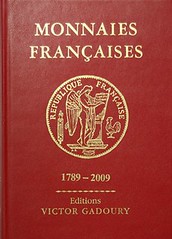
About UsThe Numismatic Bibliomania Society is a non-profit organization promoting numismatic literature. For more information please see our web site at coinbooks.org SubscriptionsThose wishing to become new E-Sylum subscribers (or wishing to Unsubscribe) can go to the following web page link MembershipThere is a membership application available on the web site Membership Application To join, print the application and return it with your check to the address printed on the application. Membership is only $15 to addresses in the U.S., $20 for First Class mail, and $25 elsewhere. For those without web access, write to: David M. Sundman, Secretary/TreasurerNumismatic Bibliomania
Society AsylumFor Asylum mailing address changes and other membership questions, contact David at this email address: dsundman@LittletonCoin.com SubmissionsTo submit items for publication in The E-Sylum, just Reply to this message, or write to the Editor at this address: whomren@coinlibrary.com
BUY THE BOOK BEFORE THE COINYou won't regret it! |
- WAYNE'S WORDS: THE E-SYLUM FEBRUARY 14, 2010
- SKLOW SALE #10: Q. DAVID BOWERS RESEARCH LIBRARY PART II
- STACK'S MARCH 2010 BALTIMORE SALE FEATURES ELIASBERG LITERATURE
- BOOK IN PROGRESS: TENNESSEE OBSOLETE PAPER MONEY
- TROUVAILLES ET TRESORS MONETAIRES EN BELGIQUE VOLUMES PUBLISHED
- NEW BOOK: WORLD PAPER MONEY ERRORS
- BOOK REVIEW: MONNAIES FRANCAISES 1789-2009 BY VICTOR GADOURY
- NEW JOURNAL: MONETA (OTTAWA COIN CLUB)
- SOLD OUT: HISTORY OF THE CALIFORNIA GOLD RUSH BY Q. DAVID BOWERS
- COLONIAL NUMISMATIC BOOK AND CATALOG SURVEY PUBLISHED
- THE EARLIEST FIVE-POINTED STAR ON A U.S. COIN?
- SHOPPING FOR GOLD COINS IN 1960
- QUERY: THE CHROME PENNIES OF 1954
- INDIANA JONES AND THE QUEST FOR FOOD STAMP CHANGE TOKENS
- COMMENTS ON DICK JOHNSON'S OPEN LETTER ON COINAGE
- MORE STACKS AND STACKS OF BOOKS
- MORE ON THE DEAR JOHN MOVIE'S NUMISMATIC SUBTHEME
- MERCURY HEAD DIME ON MERCURY HEAD WINE
- MORE ON COPYRIGHTS AND THE NUMISMATIC AUTHOR'S DILEMMA
- THE BISHOP'S WOOD HOARD OF ROMAN COINS
- DESIGNING THE 2010 WINTER OLYMPIC MEDALS
- MAKING THE 2010 OLYMPIC MEDALS AT THE ROYAL CANADIAN MINT
- RARE COIN DEALER SUES GOOGLE FOR ADDRESS MIXUP
- NEW 2010 LINCOLN CENT LAUNCHED
- HEADS ROLL AT THE CHILEAN MINT OVER COIN'S SPELLING MISTAKE
- 2005 ISLE OF MAN GOLD CROWN
- FEATURED WEB SITE: CHINA NUMISMATIC GALLERY
WAYNE'S WORDS: THE E-SYLUM FEBRUARY 14, 2010

Among our new subscribers this week are Andrew Keene, courtesy of Neil Shafer, Luke Griffin, and F. L. Noel. Welcome aboard! We now have 1,326 subscribers.
Thanks to John Salyer for helping load several of this week's image file on our Flickr archive. This week we open with a note from David Sklow, followed by information about numismatic literature items in an upcoming Stack's sale. Next, we have articles about five numismatic books and journals.
To learn about the Bishop's Wood hoard, chrome pennies, President Lincoln's backside and Vito's goons, read on.
Wayne Homren
Numismatic Bibliomania Society
SKLOW SALE #10: Q. DAVID BOWERS RESEARCH LIBRARY PART II
Numismatic literature dealer David Sklow's Sale #9 closed yesterday. He writes:

Sale #9 Closed Saturday February 13, 2010. A hearty thank you to all bidders and consignors! Prices realized will be posted [as soon as possible] on my web site, www.finenumismaticbooks.com.
I don't have a full report yet on the sale as I am still trying to close it! BIDS! BIDS! BIDS! I'm still processing faxes and emails. But here are some highlights from sale 10.
- OVER 250 LOTS OF GOLD RUSH, CALIFORNIA, NEVADA, COLORADO AND THE WEST
- SEVERAL SCARCE WORKS BY NOLIE MUMEY
- UNIQUE SIGNED LETTER FROM WALTER BREEN
- THE COMPLETE 1832 EDINBURGH ENCYCLOPEDIA [WITH NUMISMATIC PLATES]
- PRIVATE GOLD COINAGE OF CALIFORNIA 1913 ORIGINAL BY ADAMS
- 1842 FIRST EDITION ECKFELDT & DU BOIS
- THE BECHTLERS AND BECHTLER COINAGE 1929
- DELUXE LEATHER 1931 PRIVATE GOLD BY WAYTE RAYMOND
- DELUXE LEATHER LIMITED NUMBERED EDITION PRIVATE GOLD BY DONALD KAGIN
- DELUXE LEATHER BUFFALO NICKELS BY DAVID LANGE LIMITED NUMBERED EDITION # 25 OF 25
- DELUXE QUARTER LEATHER EDITIONS OF GEORGE KOLBE'S PART I & II OF THE JOHN J. FORD JR. LIBRARY
- LONG RUN OF WOODWARD NINETENNTH CENTURY AUCTION CATALOGS
- LONG RUN OF STEIGERWALT FIXED PRICE LISTS
- THE WORLDS GREATEST COLLECTION OF U.S. GOLD & U.S. SILVER BY KOSOFF, DELUXE QUARTER CALF, LEE F. HEWITTS PERSONAL COPIES, EX: CHAMPA SALE PART III
- LONG RUN OF THE BRITISH NUMISMATIC JOURNAL
- LONG RUN OF SEABY'S COIN AND MEDAL BULLETIN
- THE COMPLETE CATALOGUE SERIES OF THE COLLECTION OF RICHARD CYRIL LOCKETT BY GLENDINING
- LONG RUN OF SPINK'S NUMISMATIC CIRCULAR
- RARE GROUPING OF SUPPLEMENTS TO THE SPINK NUMISMATIC CIRCULAR 1898-1911, SOLD PRIVATE TREATY TO REV. CULNAN BY KENNETH LOWE IN 1991
- VERY RARE 1854 ORIGINAL, THE ANNALS OF SAN FRANCISCO BY FRANK SOULE WITH 150 ENGRAVINGS
- LONG RUN OF NINETEENTH CENTURY AUCTION CATALOGS
- AND MUCH, MUCH MORE!
STACK'S MARCH 2010 BALTIMORE SALE FEATURES ELIASBERG LITERATURE
From the Stack's Thursday email update:
Of particular interest in this sale will certainly be the various appraisals, inventories, and reference books from the Eliasberg Collection. This represents an historic opportunity for collectors to acquire spectacular additions fit for the finest numismatic libraries. Available here are twenty-six lots of inventories filled with fascinating information about this famous collection, personal copies of numismatic references and auction catalogues.

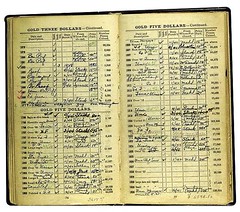
From the lot description:
Green, Ben E. The Numismatists' Reference and Check Book. 1926. Third edition, revised by Guttag Brothers. Black leather binding, with gilt lettering on cover, "L. ELIASBERG." Fine.
Measuring a compact 3.75 by 6.5 inches in size, easy enough to tuck into a pocket, it contains 129 numbered pages listing varieties from half cents to double eagles, plus encased postage stamps, private gold issues, and more. Spaces are provided for a basic checkmark to verify ownership, a column for condition or grade (which Louis Eliasberg filled out with a shorthand numbering system), the date purchased, and the source. Coins from the collection of John M. Clapp, and his successor and son, John H. Clapp, are separately listed with the notation they were purchased in July 1942, this being the famous $100,000 transaction in which he purchased the Clapp Collection intact, based upon an appraisal made by John Zug, a prominent dealer located in Bowie, Maryland.
Other items are entered individually. For example, an 1873 trade dollar in "condition 1" (Proof) was purchased from S. Henry Chapman in 1926, an early acquisition. The price paid is given in code. On the other hand, an 1874-CC trade dollar is described as Fine grade, with no numerical grade abbreviation, and was valued at $1 when acquired from the Clapp Collection. Among miscellaneous examples, a Proof 1856 Flying Eagle cent was bought from the New York Coin Company in 1927 for $60.
To read the complete lot description, see:
Green, Ben E. The Numismatists' Reference and Check Book. 1926. Third edition
(www.stacks.com/lotdetail.aspx?lsid=AN00000760
&asid=&lrid=AN00166896)
BOOK IN PROGRESS: TENNESSEE OBSOLETE PAPER MONEY
Recently The E-Sylum carried an interview from the Chattanooga Times Free Press of Tom Carson and Dennis Schafluetzel which we gave based on our presentation to the local Civil War Council in January. Our talk focused on how financial transactions were conducted using a mixture of Confederate States of America, state chartered banknotes and local scrip to replace silver and gold coinage which was being horded.
We used images of bank notes and scrip from the 14th edition of our electronic "Chattanooga Money" CD book to illustrate the myriad of currency types used during the war. During the interview we discussed our ongoing current project to develop and eventually publish a book on scrip and obsolete banknotes from the state of Tennessee.
Since the reprint of the interview, we have received congratulations from several The E-Sylum readers for completing our Tennessee obsolete book. We thank you, however, the work on the Tennessee state book is still in progress.
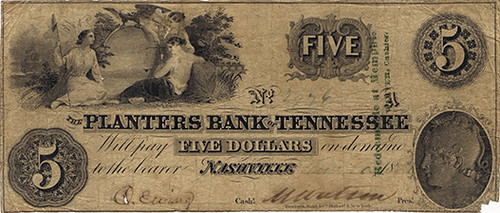
We are developing the Tennessee obsolete book on the web with historical information and scans of banknotes and scrip. Many dealers, collectors and auction companies have contributed information and scans of the notes and scrip. We have added all the scrip issues we know of to the website.
The banknotes from all branches of the Union Bank, Planters Bank, First Bank of Tennessee and the Second Bank of Tennessee have been added to the site in the past few months. If you would like to review, follow or contribute to the book use the following instructions:
Go to the book's web site at www.schafluetzel.org . Click on Tennessee Obsolete Merchant Scrip & Banknotes link and it will ask for your user name which is SPMC, and password which is SPMC6000 in both cases SPMC must be capitalized. The title page will appear. Select one of 100+ Tennessee cities, counties or railroads to view known merchant scrip and bank notes from that location. Need your help to review and contribute historical information, color images, new scrip listings, upgrades and corrections.
To read the earlier E-Sylum article, see: NEW CD BOOK: CHATTANOOGA MONEY BY DENNIS SCHAFLUETZEL (www.coinbooks.org/esylum_v13n05a05.html)
TROUVAILLES ET TRESORS MONETAIRES EN BELGIQUE VOLUMES PUBLISHED
I have the pleasure to inform you that two volumes of the collection Moneta are available, in the series of J.-L. Dengis, Trouvailles et tresors monetaires en Belgique: Moneta # 102, III. Province de Luxembourg, Du moyen age a 1794, 2010, 148 pages, € 45 Moneta # 103, IV. Province de Liege, Du moyen age a 1794, 2010, 232 pages, € 55
(
I remind you that the European network project in still in progress (see video) http://www.youtube.com/watch?v=O1EOr1mT_Kc
Author Morland Fischer's comprehensive collection reflects the attraction and advantages of exploring foreign printing errors. An overview of collecting paper money errors in today's numismatic market offers insights on the great disparity between domestic and world notes. Market values are discussed, acknowledging what variables make an error note precious in the trade. Incorporating these concepts and more, Fischer expands the method of collecting currency errors by introducing a Foreign Error Note (FEN) scale to gauge price levels based on error type.
With over 200 examples of dramatic, colorful and intriguing foreign paper money errors, collectors and spectators alike are exposed to a new form of collecting currency. The numismatic community will benefit from this thorough guide that is unlike any other on the market.
ISBN-10: 1-933990-25-2
For more information, see:
World Paper Money Errors
(www.zyruspress.com/world-paper-money-errors.aspx)
Monnaies francaises is France's equivalent to A Guide Book of United States Coins. Funny enough, it is also nicknamed "Le Rouge" (the Red). First published in 1973 by Victor Gadoury, a Canadian military man who became a professional numismatist following his discharge in Germany and who would ultimately set up shop in Monaco. Gadoury passed away in 1994 and the publishing firm was purchased by two of his long-time contributors: Francesco Pastrone and Romolo Vescovi.
Le Rouge contains information of all French coins since 1789 presented in chronological order by denomination (smallest to largest). This information includes: metal, fineness, weight, diameter, edge, engraver and privy marks. Mintage figures are provided by date and mint mark for each denomination, with the current values in euro for five grades.
Also includes obsidional coinage for the sieges of Mainz and Antwerp and special sections on commemorative coins, coins of Monaco (1819-2009), coins of Corsica (1736, 1762-68), coins of Saarland (1954-55), and a detailed illustrated guide for all privy marks.
Published on odd years, this high quality book is well worth the investment for all interested in the subject. For more information or to order, please contact the Editions Victor Gadoury at 57, rue Grimaldi, 98000 Monaco.
Email:
contact@gadoury.com
A sneak peek of the February issue is also available of the club's home page. Membership includes access to unlocked pdf versions of Moneta and well as previous journals back to 2005. The club plans to eventually have all its journals (back to 1955) available to members on its website.
Dave Bowers writes:
Most of us involved at the epicenter of this consider the SSCA treasure, absolutely unique as no greater treasure was ever lost at sea (and thus no greater can ever be recovered), to be a high point of our numismatic careers. Absolutely incredible. Absolutely unforgettable! And, we are all delighted that the coins and ingots have continued to be highly treasured in the aftermarket.
Regarding this week's Sklow sale of Dave's research library,
Jeffrey P. LaPlante writes:
The auction of a portion of David Bowers' library is I feel a very important auction. In the years to come the auctions of the Stack Family Library and the Bowers sales and others of course, at the start of this new century, will have been a bit of American history. The baton is passed to another generation, as it were. If you have read Bowers' work on the Garrett collection, there were similar auctions at the turn of the last century where those great collectors from the 19th century passed on to greater glory, leaving us mere mortals with their business.
I think Bowers will go down as the greatest numismatic historian of the past century. He brought the 19th century to life in his volumes and for that I am grateful, as I am sure others are too. It looks like it might be up to someone else to write the histories of the 20th century. The 21st century lies before us and history lies waiting for that someone to make it.
Ray Williams writes:
I received my C4 Newsletter yesterday and the Colonial Numismatic Book and Catalog Survey is there. I was impressed with what the NBS did with their survey and it inspired me to have one done in the colonial community.
It's interesting to note where different books and catalogs place. The mindset of the participants seem to be specific to what they collect, as colonial collectors generally specialize in an area. Take for instance where Syd Martin's book on Wood's Hibernias places with respect to Miller's reference on Connecticut Coppers. Surely Syd's book has set a new standard to which authors should strive to write books on specialty topics. But the number of Wood's Hibernia Collectors is far fewer than the number of Connecticut Collectors.
There are many observations to be made from the posted survey results and can they can be the topic of many good numismatic conversations for a time to come. In any case, it was a fun project and C4 Member Steve Frank is to be thanked for his work to make it happen, I'm glad I twisted his arm to take on the project! I'm not ashamed that I stole the idea from NBS and I will steal (borrow) a great idea from wherever I can find one.
As a member of C4 (the Colonial Coin Collectors Club), I received my issue earlier this week as well. Congratulations to the club and compiler Steve Frank. His article discusses the survey methodology as well as the results, which include separate rankings for books, catalogs, and web sites.
There are a lot of importance decisions to be made in running such a survey and presenting the results. The article does a good job of discussing the pros and cons of various approaches, which will be useful for those compiling such surveys in the future.
One feature missing from the C4 survey are descriptions of each of the books and catalogs listed. The published version of the NBS survey of the 100 Greatest Works of Numismatic literature included a paragraph or so about each book, written by Len Augsburger.
I won't spoil the suspense and publish the results, but not surprisingly, some of the same works that scored high in the NBS survey also scored well here.
Last week Mark Borckardt asked:
What is the earliest appearance of a five-pointed star on any U.S. Federal regular-issue coin?
Bob Hewey writes:
Tom DeLorey writes:
Mark Borckardt writes:
To read the earlier E-Sylum article, see:
QUERY: EARLIEST FIVE-POINTED STAR ON A U.S. COIN
(www.coinbooks.org/esylum_v13n06a09.html)
Tom Kays writes:
I found some great Life Magazine black & white noir images taken by Al Fenn in November 1960. Titled "Gold coins in a coin collector's store they were taken in Philadelphia and New York. I'm just curious but I'll bet the E-Sylum readership can reconstruct which stores, who are the folks, and what gold coins they are looking at.
One appears to be a high relief St Gaudens Double Eagle and another is an octagonal union. What do you guess these coin treasures would have been priced in 1960? If anyone pictured responds, do they remember Al Fenn, Life photographer, shooting them as they shopped?
To view more photos, use the More button here:
Gold at US Mint.
Tom Kays writes:
At the Google Life Magazine images site, try searching for "chrome pennies.” What was going on in 1954 regarding 24,000 chrome pennies needing to be recalled per the Secret Service? There are several fascinating images of the chrome pennies, and later signs imploring their recall.
Neil Shafer writes:
Recently food coupons have been in the news with an article in Coin World and other sources having to do with the recent acquisition by the Smithsonian of a wonderful group from USDA. I was the donor for this collection of a significant group of the "food stamp change" used by retail grocers around the country until the end of 1978.
I had been able to locate many different issues from a wide selection of cities and states over the years from 1966 to 1978, but one area of special concentration was Chicago (because I was in nearby Racine, WI and Chicago appeared to be a place with very high potential). To that end I am attaching an article I wrote for Bank Note Reporter just over a year ago, in case some readers might find it of interest. It was at times just a bit dangerous!
A friend named Jim Downey and I are working, albeit slowly, on a listing of the paper change use by food stores. Tokens (plastic, metal including aluminum and brass, cardboard, also wood in several instances) will have to wait until time allows, unless someone else is also working on such a listing.
Neil's project was national in scope, and involved a bit of sleuthing. He connected with one of the printers of food stamp change tokens and acquired examples from a number of stores all at once. He then followed up leads to chase down other examples "in the wild."
Here are a couple excerpts from the article.
-Editor
You would never suspect that there could be any kind of danger involved with the search for food stamp change- unless you venture into certain areas of any larger city. Food markets are everywhere, in safe as well as rough areas of any given place, and my adventures in Chicago trying to chase down any and all available examples of food stamp change led me into some strange and totally unsafe situations, as you will read about shortly.
Before I get into the Chicago episodes, let me just tell you one instance of what I was discovering from random contacts and calls. I took state maps of areas of the country from which I had not yet been successful in finding anything. One example was South Dakota. The map showed some of the larger metropolitan locations in heavier lettering, so I decided to call an Aberdeen information operator (you could easily do that in 1971) and find out some names of local supermarkets. The operator answered, and I told her I was working on a USDA project (sounding official of course!) and could she please tell me some names of the bigger markets in her area. I heard her then say, "Mabel, where do you shop?” They talked a minute and then she gave me a name or two. One of them was Kessler's.
I then called Kessler's and talked to the manager, telling him I was working on a USDA project involving what kinds of items had been used for food stamp change. His response: "Oh, you mean our food chips?” Without having a clue as to what he was referring to, I immediately said, "Yes, that's exactly what I mean.” It turned out that his "food chips” consisted of 1c in aluminum (1c size) and 5 and 10 cents in wood! The wooden pieces are the usual size of what we know as wooden nickels... I had totally blundered into a most unusual issue!
While driving around to addresses I had in mind, at times I would see other stores that looked promising, so I would stop and ask about store change. One place where I did this was in the area of 25th and State Streets. I found nothing there, and as I went back to my auto I noticed a number of local individuals gathering around nearby. I scurried into the vehicle and closed the window just in time to avoid someone's reaching in! I got out of there as soon as I could, needless to say.
During one of my Chicago visits I had as one objective going to the store premises of Vito's Market. Vito's was a name on one of the cardboard disks I had obtained from Letterperfect Press, so I wanted to go there for more information. At this point I do not even remember the section of the city it was in, but I absolutely do recall what took place there, as vividly as if it had happened yesterday.
I went in, asked to see the manager, and was ushered upstairs to a small square office that had two open doorways. A middle-age man of slight stature with beard stubble and small oval glasses was sitting at a desk. I recall thinking that he looked for all the world like a typical underworld character who could have come straight out of a gangster movie! As soon as I entered this little office, each doorway was blocked by a very husky-looking bodyguard type individual. Taking all this in and moving as nonchalantly as I could, I approached the desk and told him about my project. As I offered to show him some examples of other store issues I had brought with me, I raised my briefcase and opened it to remove the pieces, whereupon those bodyguards came up very close to see what I was going to bring out of my briefcase.
After he saw the items I had with me, without a word he flicked his wrist at one of the men who brought me some examples of their cardboard disks in the standard 1, 5 and 25c denominations that Letterperfect made. I thanked him and made a quick exit.
All in all, I came out with a truly amazing array of items from this one city; I also realized that if I had not been there to do exactly what I did, these issues and unique pieces of all kinds would eventually have been totally lost to the numismatic world. This fact would also hold true for most of the issues I was able to secure from everywhere else. I was lucky to find what I did end up with, and I cannot even begin to think of all the issues that really were lost because no one knew or cared to know about them, especially in other big cities where basically the same kind of foraging would have produced similar results if done properly.
Every now and then I do run into some issue that is totally new to me, either on a dealer's list or a venue like eBay, so they are still out there waiting to be discovered. The thrill of the hunt never ceases!
Joe Boling writes:
Dick Johnson's open letter was fine until he got to the dimensions of his proposed coins. None of his intended recipients will have a clue what 20mm or 35mm looks like, and all will stop reading right there. They also won't know what "clad" means. In my opinion, each of his dimensions is 5mm too large - start at 15mm, not 20mm. The present dollar coins, at 27mm, are closer to 25mm than they are to 30mm. That 50mm behemoth is not usable. As for copper nickel and nickel being distinguishable by color - only through rose-colored glasses.
I left a lot of things unsaid in my proposed U.S. coinage schedule published in last week's E-Sylum as an open letter to government officials. The most obvious -- and this is what I expected Good Friend and my most vocal critic Joe Boling to question -- what about quarters?
Quarters are a base 5, a multiple of 5, and as such do not fit in a scheme of base 10 where every coin denomination and transaction amount is divisible by 10. As such quarters, like the cent and nickel, are destined to being abolished. But not so quick for quarters. For cents and nickels, the sooner the better.
I proposed a time table that extended for ten years. In that time I was certain American inventiveness and engineering could come up with a new dime. America would need a dedicated plant -- a mint -- for the exclusive purpose of striking and manufacturing a single product, a ceramic coated aluminum dime. In that ten-year period we would need a lot of half dollars, and here is were I saw using quarters in tandem being used to full extent. If the plant is in production in less than a decade, the quarters could be abolished earlier.
Buy why a ceramic-aluminum dime? Reasons: (1) aluminum is plentiful, (2) it is cheap, as compared to other coinage metals, (3) it is easily coined. But because of these reasons aluminum alone is easily counterfeited. Thus the need for a second composition that makes counterfeiting difficult if not impossible.
Ceramic is ideal. It is the coating on capsules as a heat shield, hard and impervious to extremes of pressure and heat. Also we have some experience in the use of ceramic in a related field to coining -- the manufacture of buttons! So engineers could adapt the technology from two fields: space age technology and button manufacturing technology. Engineers would have to solve the problem of how to bond the ceramic surface to a partially coined aluminum disc. Just the thought of that should deter wannabe counterfeiters.
The smooth ceramic surface would appear on one side of the dime -- imprint it in color if you wish -- with a relief image of the aluminum on the other side. This makes an ideal coin which meets all necessary criteria of low cost for a low denomination coin, and other customary criteria of coins as: recognizability, vending machine suitability, hardness, somewhat low weight, national image, value and lettering -- and longevity. Such coins should last in circulation longer than the average 22 years of a typical coinage composition.
Joe Boling made a good point I didn't - my metric dimensions. So here 'tis:
Joe complained the $50 coin is too big. If I am going to carry a coin worth $50 I would want it sizeable. Remember these are coins for modest cash transactions. Paper money and electronic payments would still exist for large transactions.
But what would Joe say for the $100 coin? It would be larger than 2 1/8-inches -- 55mm -- 2.16535-inch. Ditto.
Joe also didn't question the recalling of the cents and nickels at the end of that ten-year period. I will get into that next week. Hit me with your best questions, Joe (and anyone else who wants to step up to the plate).
To read the earlier E-Sylum article, see:
AN OPEN LETTER TO CONGRESS, THE TREASURY AND MINT OFFICIALS
(www.coinbooks.org/esylum_v13n06a16.html)
Dave Lange writes:
Based on the photo of his library, it looks like P. Scott Rubin is a candidate for one of my favorite television shows --- Hoarders. Each week it profiles two individuals living in different parts of the country whose compulsive hoarding threatens to cost them their homes, spouses and/or children.
My wife accuses me of being a hoarder, but I hasten to point out to her that each coin board, folder or album is unique in some way and is necessary for my ongoing cataloging project. Nevertheless, she is not convinced that this justifies expanding the collection into the spare room.
Stephen Searle writes:
After seeing George Kolbe's "vision" of P. Scott Rubin's library, I was reminded of the "bookstore" in the attached photo.
One day, I will have to get off the bus and find out the purpose of that store (other than, perhaps, to keep the workers busy).
Mexican bookstores are an interesting phenomenon. The owners never seem
to discard any book, no matter how useless I would think it is. So the clutter tends to build up fast, and it becomes hard to find anything good, or anything at all.
I've visited the "good" used bookstores downtown with piles of books in front of the bookcases such that one cannot get books from either the bookcase or the pile (because its 6 feet high). They seem to be in no hurry to move inventory.
To read the earlier E-Sylum article, see:
THE P. SCOTT RUBIN NUMISMATIC LIBRARY
(www.coinbooks.org/esylum_v13n06a06.html)
Ron Guth writes:
Regarding the "Dear John" movie...my teenage daughter asked me over dinner if there was such a thing as a mule. I thought it was a trick question about the animal, but she meant a coin. Apparently, Channing Tatum has a rare mule that he takes to a coin shop, where he is offered little or no money for the coin. He decides to hang onto it and sells it later for thousands of dollars. Is this numismatic sub-plot compelling enough for me to see the movie? NO! My wife convinced me to watch Amanda Seyfried in "Mamma Mia." That was quite enough, thank you.
American Numismatic Society librarian Elizabeth Hahn writes:
I admit that I have no desire to actually go see this film, but was curious to know what the numismatic sub-theme was. There is an ample description on Wikipedia that explains all manner of the theme, so for anyone interested in spoiling the plot, see:
en.wikipedia.org/wiki/Dear_John_(2010_film)
.
To read the earlier E-Sylum article, see:
QUERY: DEAR JOHN MOVIE'S NUMISMATIC SUBTHEME
(www.coinbooks.org/esylum_v13n06a20.html)
Tom Sheehan forwarded these images of a coin-themed bottle of "Mercury Head" wine.
The simple fact is that all works are assumed to be copyrighted under the Berne Convention. The USA signed on in January 1985, one of the last acts of the Reagan Administration. Even China is a member (1992).
The World Intellectual Property Organization website is here: http://www.wipo.int/
Additional protection under US Law is also available via the US Copyright Office (http://www.copyright.gov/).
Whether it is legal or not, it is certainly immoral to take the work of another person and put your name on it. Anyone who does not understand the philosophical depths of the question might read Ayn Rand's novel "The Fountainhead" for insight into the soul of a second-hander versus the soul of a creator.
I am not a licensed attorney, but I have studied copyright law to some extent, and it seems to me there are several questions that need to be answered to determine to what extent #3 can use material from #1 and #2.
First, what sort of material does #3 want to use? Copyright protects original works of scholarship, and while the threshold for originality is pretty low, the Supreme Court has said that phone books are not original enough. It is absolutely true that new works build off of older material, which is why facts and ideas are not copyrightable and copyright on original works eventually expires (although works produced right now have very long terms). The raw information (e.g., "a coin exists with this die variety") is not copyrightable. Like you said, photos and special numbering or cataloging systems may be original enough to be copyrightable, but the basic listings are probably not.
Second, how old are #1 and #2's books? If they are really old, their copyrights might have expired. There is a great chart on copyright terms under U.S. law at http://www.copyright.cornell.edu/resources/publicdomain.cfm.
Third, is there any way to contact the author and request permission? It is always safest to get permission, even if it is not technically necessary. #1 and #2 might be dead or unfindable, but it is worth at least doing a basic search. It is also kind and prudent (although not required by U.S. law) to provide attribution if possible, perhaps in an acknowledgements section.
Shameless (but timely) plug--I have an essay coming out in the March issue of The Numismatist discussing how authors should think about adding permission licenses to their works so that future researchers can have a clear idea on how their works can be reproduced and repurposed in new ways. These mechanisms were not very prevalent in the past, but present authors can grant permissions that may help future readers by reducing the occurrence of these dilemmas.
So, #3 has a good chance of being able to use data from #1 and #2 if their copyrights have expired, if #3 is just reproducing the basic facts, or permission can be obtained. If #1 and #2 have not registered their copyrights, they cannot sue #3 for infringement until they register with the U.S. Copyright Office (of course, following the law is more than just avoiding lawsuits).
Copyright is a rather fact-specific area of law, but it is hard to know precisely what to do without knowing all the details of a given situation, but I hope these general thoughts are helpful to authors thinking about using parts of copyrighted works.
I certainly don't have any definitive answers, but I would like to raise
a couple of points and a suggestion or two:
"Neither #1 or #2 copyrighted their books." With only the vaguest hints
as to date and place of publication for the two existing books, it's not
possible to know, but author #3 should keep in mind that, particularly
if written only "a few years ago," many works are automatically
copyrighted as a result of being created, and failure to put a copyright
notice on the work doesn't actually mean that it's not copyrighted. To
be specific, currently in the U.S. something is "under copyright
protection the moment it is created and fixed in a tangible form." There
are still good reasons to put the copyright notice on published works,
but a failure to do so doesn't mean something's necessarily free for the
taking.
Are authors #1 and #2 still alive and their contact information known or
findable? If so, the most forthright way for author #3 to proceed might
well be to simply ask for permission. Particularly if author #3 is
willing to walk away from the project in face of an adamant refusal.
On the other hand, if #1 and #2 are both dead, and the works were
self-published or the publishers are also gone, then a quick
consultation with an intellectual property lawyer about how unlikely it
is that anyone cares enough to send a cranky letter, never mind sue,
might be a good investment.
Keep in mind that entire thing is an exercise in risk assessment. Is the
copyright holder around to care? Is he already working on a new
edition? Is anybody making enough money on any of this to pay for a
lawsuit in the first place? Are you planning on copying significant
percentages of the text, photos, or the numbering scheme, which as Wayne
pointed out is more problematic, or simply ensuring that every published
die variety also shows up in the new book, which, as "mere" compilation
of facts, tends to have less copyright protection.
People reprint entire works without permission and get away with it.
Other people get sued for copying works they've never heard of, never
mind ever seen, though that generally doesn't happen until you're making
as much money as J.K. Rowling. That, sadly enough, doesn't happen to
authors of numismatic books (the money part, that is). ;-)
See http://www.copyright.gov/help/faq/faq-fairuse.html for more.
I also have a quibble about how the questions were framed in the first
place. There appears to be a conflation of two related, but distinct,
matters:
1) Avoiding copyright violations, or at least being sued over them, and
2) Giving credit and acknowledging sources for your information.
They're different. Mess up number 1 and you're talking money, lawyers,
and the law. Mess up number 2 and you're talking about plagiarism,
academic censure, and questions about the worth of your research.
In the best of all worlds, you'd take care of number 1 with permission
from any and all existing copyright holders, and you'd take care of
number 2 by acknowledging your debt to those who came before in the
introductory material in the front of the book, putting quote marks
around any direct quotes, footnoting any facts or opinions which are not
common knowledge or derived from your own observations, and putting a
bibliography in the back that lists all the works from which you took
inspiration or which would be of interest to your reader in further
studying your topic.
To read the earlier E-Sylum article, see:
A NUMISMATIC AUTHOR'S DILEMMA
(www.coinbooks.org/esylum_v13n06a10.html)
Baldwin's are delighted to announce that they will be offering a portion of Roman coins from the Bishop's Wood Hoard of 1895 for sale by auction. This hoard of Roman coins will be auctioned alongside the Michael Hall Collection of Renaissance Medals at their May 4-5, 2010 London event.
The extensive hoard was unearthed at Bishop's Wood, near Ross-on-Wye, just across the Herefordshire border and within the surroundings of the Forest of Dean. Several other, smaller finds, of similar coins had also been found along this route but none as vast or as interesting as this. It was discovered in a rough walling built against the hillside by workmen who were in the process of repairing a road and who struck an earthenware vessel containing the coins. The accidental strike from a pick broke the jar and scattered its contents in various directions.
Details of the hoard were first published in the 1896 edition of the Numismatic Chronicle, and also in the editorial of the Numismatic Circular in November of that year.
Many of these coins were subsequently given to local museums and the portion now being sold by Baldwin's (containing 1,661 coins and the restored jar that contained them) has remained in the family of the original landowner since they were found in 1895.
To read the complete article, see:
The Bishop's Wood Hoard of Roman Coins
(news.coinupdate.com/the-bishops-wood-hoard-of-roman-coins-0145/)
To read the complete article, see:
Making the Olympic medals
(news.bbc.co.uk/2/hi/programmes/world_news_america/8511899.stm)
When Olympic champions are crowned at this year's winter games in Vancouver, these elite athletes will be taking home more than just gold, silver or bronze medals—they will be playing a role in Canada's efforts to reduce electronic waste. That's because each medal was made with a tiny bit of the more than 140,000 tons of e-waste that otherwise would have been sent to Canadian landfills.
The more than 1,000 medals to be awarded at the Vancouver 2010 Olympic and Paralympic Winter Games, which kick off today, amount to 2.05 kilograms of gold, 1,950 kilograms of silver (Olympic gold medals are about 92.5 per cent silver, plated with six grams of gold) and 903 kilograms of copper. A little more than 1.5 percent of each gold medal was made with metals harvested from cathode ray tube glass, computer parts, circuit boards and other trashed tech. Each copper medal contains just over one percent e-waste, while the silver medals contain only small traces of recycled electronics.
This is the first time that recycled materials have been added to Olympic medals, which historically have been made from mined mineral deposits refined for commercial use. Each Olympic medal is 100 millimeters in diameter, about six millimeters thick and weighs between 500 and 576 grams, depending upon the medal.
To read the complete article, see:
(www.scientificamerican.com/blog/post.cfm?
"Their true journey starts now," says Renato Romozzi, the mint's design coordinator.
"When these medals find their rightful owners, they are going to represent Canada all over the world. We're so proud. They're such beautiful medals." The mint assembled 34 engineers, engravers, die technicians, machinists and production experts to make the 615 Olympic and 399 Paralympic medals.
It was probably the most challenging job ever faced by the mint, says Romozzi, 53.
"I don't think we've made anything that comes close to the complexity," he says.
"We've never put together a group of people like we did for this medal; a lot of people, a lot of technologies." It was the final step of a two-year creative process that spanned the country.
Viewed from the side, the medal forms a gentle wave shape, inspired by the ocean, mountains and snow drifts of British Columbia.
"They will be unique," says Jim Greensfelder, a Florida collector who wrote a reference guide to Olympic medals.
"There's never been a medal that's had that (wavy) contour," he says. "People will recognize it as being very distinctive for Vancouver and Canada." No two medals are alike. Each of the 1,104 medals is engraved with a different segment cropped from two drawings by Hunt.
She chose to depict a killer whale or orca on the Olympic medals "because of its strength and beauty and athleticism, as well as the idea that the orca travels within its community," she says.
"All the medals together make the complete art work," says Arbel. "Every athlete's story is unique, but together they're part of a larger Olympic whole." Weighing between 500 and 576 grams, the medals are among the heaviest in Games history.
"Athletes like them heavier," says Greensfelder. "They feel like it's more substantial, that it's worth more." The Olympic medals are circular, 100 mm in diameter. The Paralympic medals are a squared-circle and measure 95mm by 95mm.
For the first time, Paralympic medals are equal in size to Olympic medals. "Paralympic are usually much smaller," says Romozzi. "These set the standard now for the rest of the world to follow.
"The challenge for us was to strike a medal with bumps," says Romozzi. "This is not something that is very common in our industry. Coins are flat. Some have high relief, but nothing like this." They experimented with press settings and designs of dies, metal blocks imprinted with undulations which give the medals their shape. Many early attempts were melted down.
"Our guys did the most incredible thing," says Romozzi. "They did something the (machine's manufacturer) didn't know you could do. They trained the laser to know what the rings were. They would jump over, laser inside and jump out." On the reverse side, the medals contain the official names of the Games in English and French, Vancouver 2010's emblems, and the name of the sport and event the medal was awarded in. Finally, each medal is clad in transparent protective coating to prevent wear and tarnishing.
After 402 days, the medals were finished. The $2 million feat was part of the mint's sponsorship of the Games.
"They shipped out Jan. 8, so we lost them," says Romozzi. "It was a sad moment. We got so attached to them." In the search for a medal that would reflect Canada and delight athletes, the design team learned "just how much meaning a small object could have," says Arbel.
To read the complete article, see:
Minting the medals on Sussex Drive
(www.ottawacitizen.com/sports/Minting+medals+Sussex+Drive/2562800/story.html)
A Jupiter man in the rare coin industry is accusing Google of invading his privacy and causing emotional distress for incorrectly posting his home address instead of listing the location for his Stuart-based company.
In a lawsuit he filed Monday in Martin County Circuit court against Google Inc., Jonathan Harris claimed that having his home address associated with the sale of rare coins leaves him and his family members targets for a home invasion, or worse.
Google "publicly disclosed that the plaintiff's family home is where rare coins can be found, and conveniently provided a map,” wrote Harris, who is acting as his own attorney.
"A reasonable person who is in the rare coin business would find this objectionable and highly offensive,” he added, "even if the person did not have a family.”
In his suit, Harris claimed Google ignored its own policy to remove sensitive information within 48 hours of a written request. He wants a judge to issue a permanent injunction to prevent Google from posting information about his personal residency.
To read the complete article, see:
Rare coin dealer sues Google for address mixup
(www.tcpalm.com/news/2010/feb/08/rare-coin-dealer
The United States Mint Thursday launches the nation's new Lincoln "Preservation of the Union” one-cent coin.
The mint is replacing the image of the Lincoln Memorial with a union shield and a scroll draped across it. The US Mint website describes the new look as "… emblematic of President Lincoln's preservation of the United States of America as a single and united country.”
The penny's design was changed last year when the mint issued four commemorative designs to celebrate Abraham Lincoln's birth. But before that, the penny hadn't had a makeover since 1959.
To read the complete article, see:
The Penny's Backside Gets a Makover
(www.nbcchicago.com/news/local-beat/The-Pennys-Backside-Gets-a-Makover-84103352.html)
Stating the obvious for anyone near Washington, D.C., the planned Thursday coin exchanges at the Union Station and the U.S. Senate's credit union for the new 2010 Lincoln Shield Cent have been canceled. Information is not available at this time as to whether the exchanges will be rescheduled.
The Washington area has been hit by a fierce winter storm for the second time in less than a week. For the first time in history, the federal government on Thursday closed for a fourth straight day. The DC winter has already entered the record books for the snowiest ever, surpassing the 54 inches that blanketed the city in 1898-1899. Highways, schools, flights and mass transit have been shut down.
2010 Lincoln Cent Exchanges Canceled in DC, Ceremonial Springfield Launch Continues
(www.coinnews.net/2010/02/10/2010-lincoln-cent
United States Mint Director Ed Moy launched the 2010 Lincoln "Preservation of the Union" One-Cent Coin today during a special ceremony at the Abraham Lincoln Presidential Library and Museum (ALPLM).
On the eve of the launch ceremony, Director Moy met with local coin enthusiasts at ALPLM, where he answered their questions and shared information about the United States Mint and its coin programs.
The reverse of the 2010 and beyond Lincoln cent was designed by United States Mint Artistic Infusion Program Associate Designer Lyndall Bass and executed by United States Mint Sculptor-Engraver Joseph Menna. The design depicts a union shield with a scroll draped across and the inscription ONE CENT. The 13 vertical stripes of the shield represent the states joined in one compact union to support the federal government, represented by the horizontal bar above. The horizontal bar features the inscription E PLURIBUS UNUM — "out of many, one" — while the inscription UNITED STATES OF AMERICA is depicted along the upper rim of the coin.
The obverse (heads) continues to bear Victor David Brenner's likeness of President Lincoln that has appeared on the coin since 1909.
To read the complete press release, see:
United States Mint Launches 2010 Lincoln One-Cent Coin
(www.prnewswire.com/news-releases/united-states-
Kentucky, Missouri and Indiana were among the states represented at the unveiling of the new coin, which came on the eve of Lincoln's 201st birthday. The line to purchase the pennies formed as early as 5 a.m. and wrapped around the Abraham Lincoln Presidential Museum shortly before the ceremony kicked off at 9:30 a.m.
"When you talk about the Lincoln penny, you have some very passionate people who love Lincoln and that is why they follow this. But you also have people who love coin collecting," said Edmund Moy, director of the United States Mint.
Some were willing to go to great lengths to get an early glimpse at the coin. Justin Pettyjohn, for instance, traveled seven hours from Louisville, Ky., to Springfield, arriving at 3 a.m. He staked out in a Wal-Mart parking lot with his stepfather, Mike Arndt, before traveling to the museum at 8 a.m.
The event was a gold mine for coin collectors like Arndt, who has been collecting since he was a child.
To read the complete article, see:
Unveiling of new Lincoln penny attracts crowd
(www.pantagraph.com/news/state-and-regional/illinois
The 50-peso coins, worth about 6p, circulated through the South American country for a year before the error was noticed.
The mint said it has no plans to take the coins out of circulation, and eagle-eyed Chileans have begun hoarding the coins in the hope they rise in value as a collector's item.
The mistake cost general manager Gregorio Iniguez and several other employees their jobs.
Last October, a staff member sold a rare medal, which should have been housed in the institution's museum, to a coin collector. A month later, another medal - this one bearing the face of the country's then President Michelle Bachelet - was inadvertently sold on the open market.
To read the complete article, see:
Boss of Chilean mint fired after thousands of coins are issued bearing a howling error: 'C-H-I-I-E'
(www.dailymail.co.uk/news/worldnews/article-1250580/
This week's Featured Web site is the China Numismatic Gallery, a modern Chinese Coin Database.
The images here are coins or medals officially issued by the People's Republic of China. All the coins here are legal tender of the P.R.C. All photos are provided by our administrators or registered members.
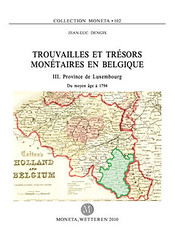
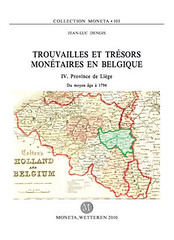
NEW BOOK: WORLD PAPER MONEY ERRORS
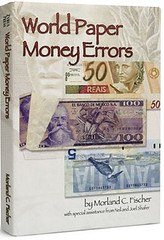 Odd shapes, upside down prints, intriguing cuts and folds, and missing design elements are only a few of the different printing errors examined in this expansive collection on foreign error notes. World Paper Money Errors is a visually compelling avenue into the fascinating and rarely explored area of numismatics that expands on the hobby of collecting paper currency.
Odd shapes, upside down prints, intriguing cuts and folds, and missing design elements are only a few of the different printing errors examined in this expansive collection on foreign error notes. World Paper Money Errors is a visually compelling avenue into the fascinating and rarely explored area of numismatics that expands on the hobby of collecting paper currency.
ISBN-13: 978-1-933990-25-5
Edition: 1
Publication Year: 2010
Binding / Size: Paperback 6x9
Photos / Illustrations: 500+ Images
Pages: 250
BOOK REVIEW: MONNAIES FRANCAISES 1789-2009 BY VICTOR GADOURY
Title Monnaies francaises 1789-2009
Edition 19th
Author PASTRONE, Francesco
Publisher Editions Victor Gadoury
Year 2009
Language French
Illustrated Yes, black and white
No. of pages 448
Size 5 3/4 x 8 1/4” – 15 x 21 cm
Binding Hardbound
ISBN 2-906602-34-5
Price 29 euro
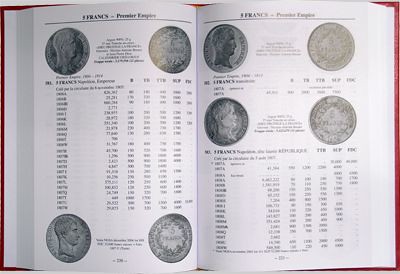
Web site:
www.gadoury.com
NEW JOURNAL: MONETA (OTTAWA COIN CLUB)
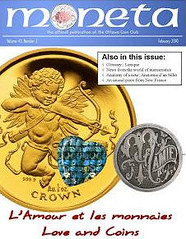 The Ottawa (Canada) Coin Club has started the new year with a new name and look for its journal. Visitors to the website (http://www.ottawacoinclub.com/) can now take a look at "Moneta" by clicking at the cover page of the January issue at the bottom of the page.
The Ottawa (Canada) Coin Club has started the new year with a new name and look for its journal. Visitors to the website (http://www.ottawacoinclub.com/) can now take a look at "Moneta" by clicking at the cover page of the January issue at the bottom of the page.
THE BOOK BAZARRE
SOLD OUT: HISTORY OF THE CALIFORNIA GOLD RUSH BY Q. DAVID BOWERS
 In view of the recent expanded coverage of the S.S. Central America by Paul Gilkes and others in Coin World, and of dynamic interest in ingots and coins from the SSCA, it might be relevant to make a note that my book, A History of the California Gold Rush Featuring the Treasure from the S.S. Central America is completely sold out. There was a printing of about 4,000 copies, all hard cover, plus an additional 400 or so in deluxe red leather to accompany one each of the ingots found.
In view of the recent expanded coverage of the S.S. Central America by Paul Gilkes and others in Coin World, and of dynamic interest in ingots and coins from the SSCA, it might be relevant to make a note that my book, A History of the California Gold Rush Featuring the Treasure from the S.S. Central America is completely sold out. There was a printing of about 4,000 copies, all hard cover, plus an additional 400 or so in deluxe red leather to accompany one each of the ingots found.
COLONIAL NUMISMATIC BOOK AND CATALOG SURVEY PUBLISHED
THE EARLIEST FIVE-POINTED STAR ON A U.S. COIN?
 The correct answer, to the best of my knowledge, is in 1814, when a five pointed star first appeared as part of the Lettered Edge on Capped Bust half dollars. Attached is a photo, the best I have available.
The correct answer, to the best of my knowledge, is in 1814, when a five pointed star first appeared as part of the Lettered Edge on Capped Bust half dollars. Attached is a photo, the best I have available.
SHOPPING FOR GOLD COINS IN 1960
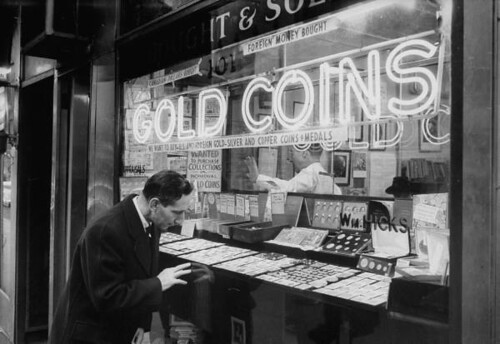
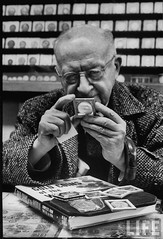

QUERY: THE CHROME PENNIES OF 1954


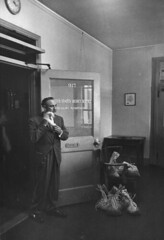
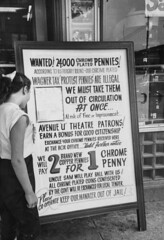
INDIANA JONES AND THE QUEST FOR FOOD STAMP CHANGE TOKENS
THE BOOK BAZARRE
COMMENTS ON DICK JOHNSON'S OPEN LETTER ON COINAGE
MORE STACKS AND STACKS OF BOOKS
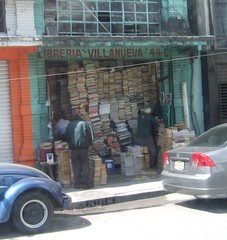 I regularly attend the conventions of the Mexican Numismatic Society in Mexico City and since I rarely stay at the host hotel, I take a micro bus from my hotel to the convention every morning. The route of the bus passes this bookstore, the Libreria Villanueva at 44-C Antonio Caso [Street], where I always see several industrious men sorting, pricing, and doing whatever it is that they do with those books. The store is always completely impassable, with a wall of towering books from the back to the front and side to side. There is no path through the books to the back of the store!
I regularly attend the conventions of the Mexican Numismatic Society in Mexico City and since I rarely stay at the host hotel, I take a micro bus from my hotel to the convention every morning. The route of the bus passes this bookstore, the Libreria Villanueva at 44-C Antonio Caso [Street], where I always see several industrious men sorting, pricing, and doing whatever it is that they do with those books. The store is always completely impassable, with a wall of towering books from the back to the front and side to side. There is no path through the books to the back of the store!
MORE ON THE DEAR JOHN MOVIE'S NUMISMATIC SUBTHEME
MERCURY HEAD DIME ON MERCURY HEAD WINE
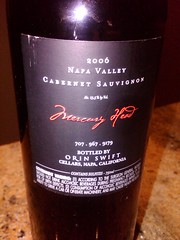
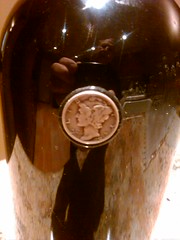
MORE ON COPYRIGHTS AND THE NUMISMATIC AUTHOR'S DILEMMA
THE BOOK BAZARRE
THE BISHOP'S WOOD HOARD OF ROMAN COINS
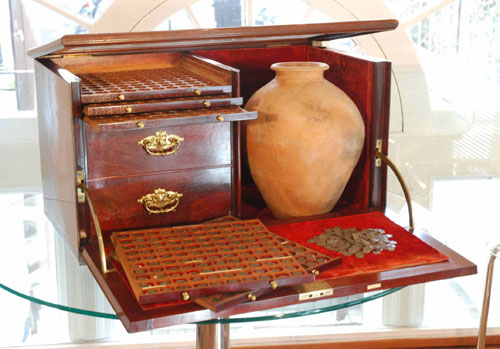
DESIGNING THE 2010 WINTER OLYMPIC MEDALS

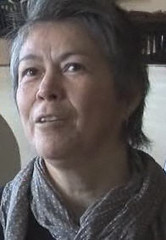 The medals for the 2010 Winter Olympics have been designed by an Aboriginal Canadian called Corrine Hunt. She spoke to the BBC about the inspiration behind her designs.
The medals for the 2010 Winter Olympics have been designed by an Aboriginal Canadian called Corrine Hunt. She spoke to the BBC about the inspiration behind her designs.
id=winter-olympic-medals-made-from-rec-2010-02-12)
MAKING THE 2010 OLYMPIC MEDALS AT THE ROYAL CANADIAN MINT
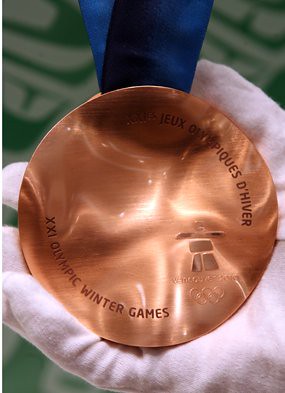 The athletes standing on the podium in Vancouver will receive gold, silver and bronze medals made at the Royal Canadian Mint on Sussex Drive. For the athletes, they represent the highest achievement in their sport. At the mint, they are celebrated as the pinnacle of craftsmanship.
The athletes standing on the podium in Vancouver will receive gold, silver and bronze medals made at the Royal Canadian Mint on Sussex Drive. For the athletes, they represent the highest achievement in their sport. At the mint, they are celebrated as the pinnacle of craftsmanship.
RARE COIN DEALER SUES GOOGLE FOR ADDRESS MIXUP
-sues-google-for-address-mixup/)
NEW 2010 LINCOLN CENT LAUNCHED
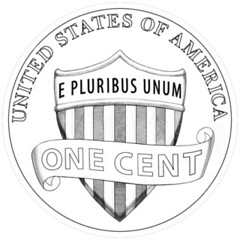 President Lincoln's backside will look a little different from here on out.
That's because the "tails” end of the penny is about to get a makeover.
President Lincoln's backside will look a little different from here on out.
That's because the "tails” end of the penny is about to get a makeover.
Ya gotta love the popular press. Numismatists will cringe twice at that headline with "Penny's backside" instead of "cent's reverse", and that's before we get to the mis-spelling of the word makeover.
Mother Nature had other plan for the event, however.
-Editor
-exchanges-canceled-in-dc-ceremonial-springfield-launch-continues/)
Anyway, the Mint issued a press release about the launch event itself, which was held in Springfield, Illinois. Here are some excerpts.
-Editor
mint-launches-2010-lincoln-one-cent-coin-84119037.html)
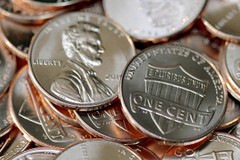 Temperatures were in the teens Thursday morning but that didn't stop a host of out-of-state residents from trekking to the state's capitol to be among the first batch of people to purchase a newly-minted Abraham Lincoln penny.
Temperatures were in the teens Thursday morning but that didn't stop a host of out-of-state residents from trekking to the state's capitol to be among the first batch of people to purchase a newly-minted Abraham Lincoln penny.
/article_641250f8-174d-11df-9f19-001cc4c002e0.html)
HEADS ROLL AT THE CHILEAN MINT OVER COIN'S SPELLING MISTAKE
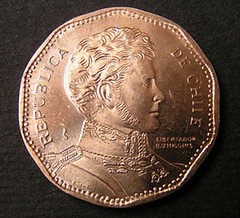 Embarrassed Chilean Mint chiefs have sacked their general manager after thousands of coins were made with the name of the country spelt incorrectly.
Instead of 'Chile', the coins, minted in 2008, are marked 'Chiie'.
Embarrassed Chilean Mint chiefs have sacked their general manager after thousands of coins were made with the name of the country spelt incorrectly.
Instead of 'Chile', the coins, minted in 2008, are marked 'Chiie'.
 The discovery of the spelling error is not the first embarrassing blunder at the Chilean mint in recent times.
The discovery of the spelling error is not the first embarrassing blunder at the Chilean mint in recent times.
Chile-mint-gets-country-wrong-coin.html)
2005 ISLE OF MAN GOLD CROWN
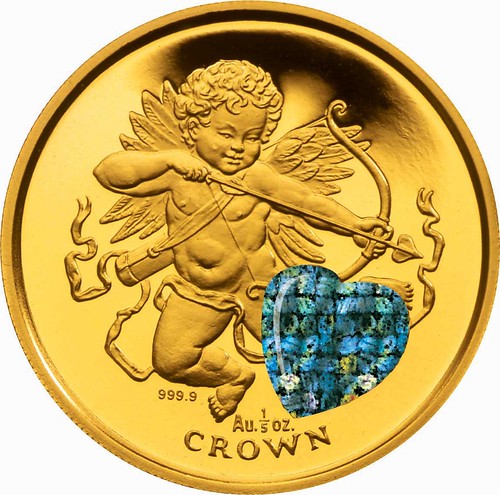
FEATURED WEB SITE: CHINA NUMISMATIC GALLERY
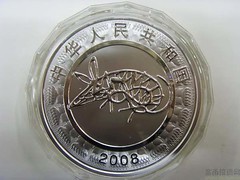
www.chinanumismatics.net/gallery/

